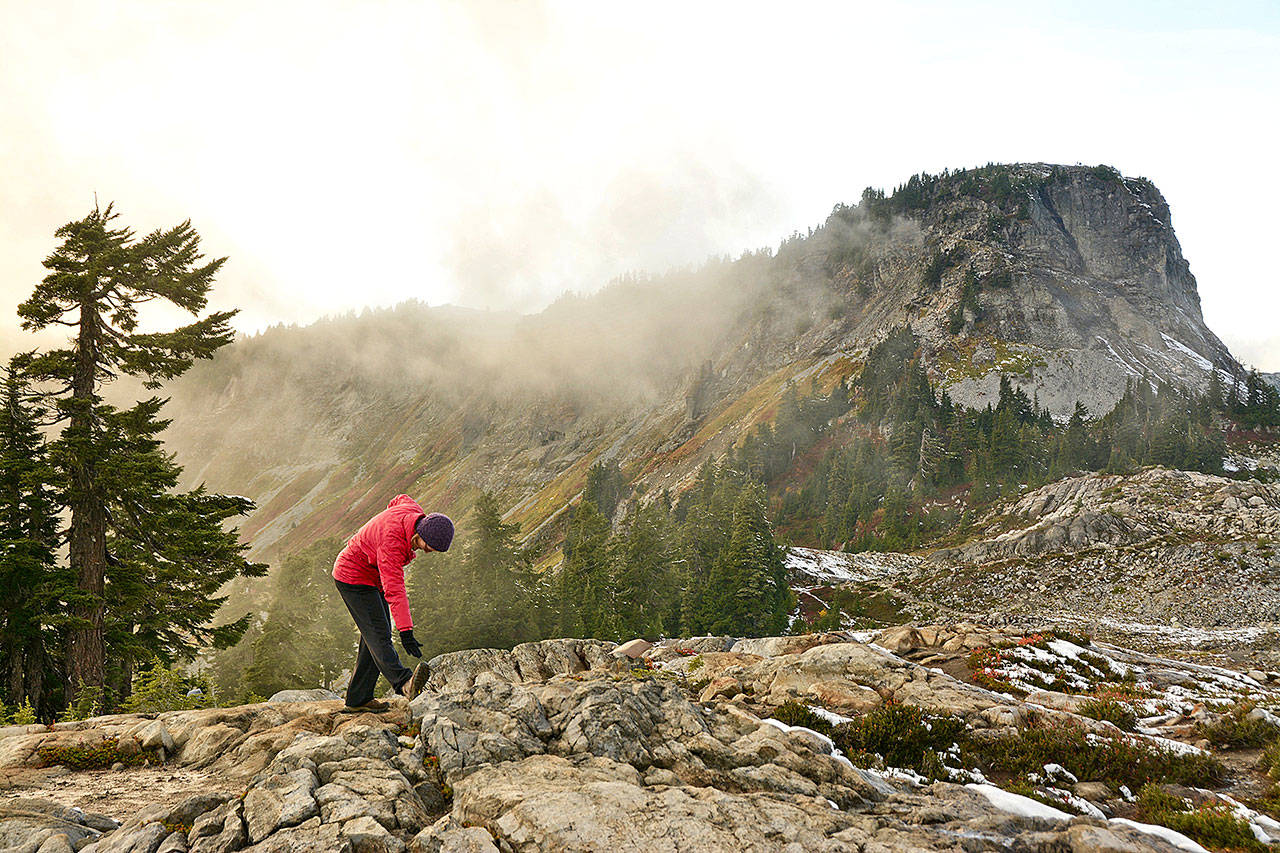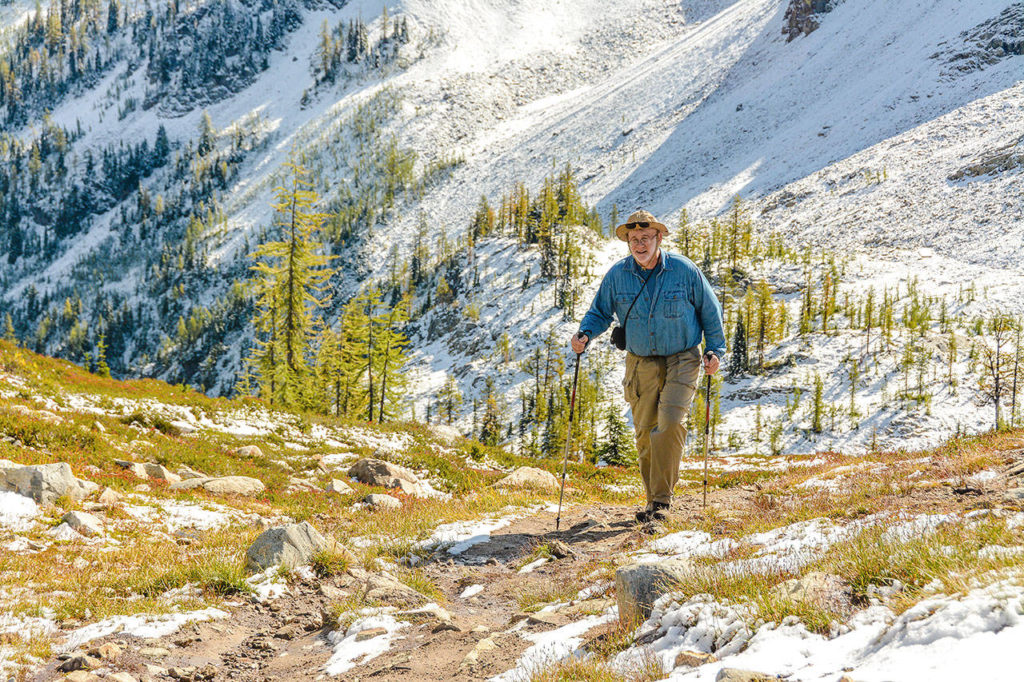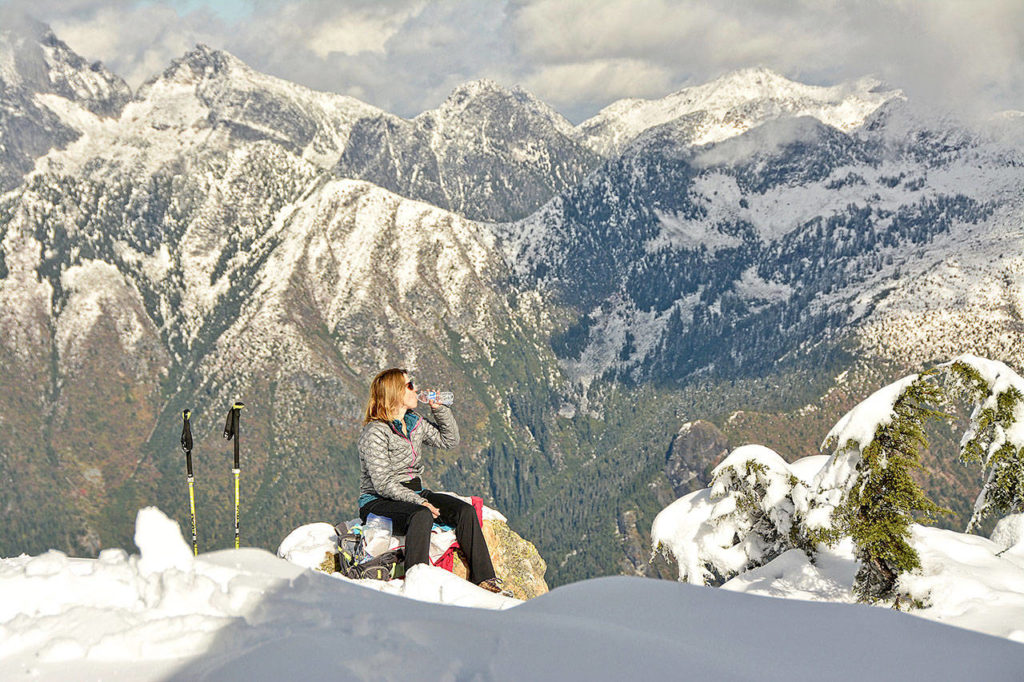By Lindsay Leffelman / Washington Trails Association
If you’ve ever had to catch your breath on an uphill stretch of trail or if your legs have felt sore after a hike, you know that hiking is a workout. You’ve also likely experienced some of the health benefits of hiking: improved cardiovascular performance, more endurance, stronger muscles and a better mood.
While many people hike simply for the enjoyment of it, there is no denying how beneficial a walk through the woods can be for your physical health.
In an age of trendy fitness studios, high-tech workout trackers and expensive personal trainers, it can be easy to forget that the simple act of hiking is an exercise powerhouse. However, scientific research and health professionals alike agree that hitting the trails is advantageous for all aspects of physical fitness.
Burning calories
For many people, the idea of burning calories is one of the first things that comes to mind when they think about working out. Our bodies use stored energy (calories) to support normal body functions and to fuel us during physical activity. While any type of physical movement will result in the body using its stored energy, the unique nature of hiking can result in greater calorie burn than other forms of exercise. In fact, research from the University of Florida concluded that walking on uneven terrain, like that of hiking trails, causes the body to use 28 percent more energy than walking on flat, even ground due to the subtle shifts in the way your leg muscles must lengthen or shorten while hiking.
So, exactly how many calories will you burn while hiking? That’s a difficult question to answer. On average, a moderate hike can burn 300 to 400 calories per hour. However, this number can be heavily impacted by a variety of factors. The weight of your pack, the speed at which you hike and the type of terrain you’re traversing all play a role in how many calories you burn. Hiking with an overnight pack on steep, rocky terrain is going to burn more calories than leisurely hiking with a light pack on a flat trail.
Increasing strength
Working out isn’t all about burning calories, though. Improved cardiovascular performance, increased endurance and toned muscles are also important outcomes of a well-designed exercise program. For hikers, the varied terrain of your favorite trails makes all of these workout goals possible.
Typically, when you’re hitting the trails, you climb on the way to your destination and descend on the way back. Climbing equates to using the stairclimber at the gym; the large muscles in your legs (glutes, quads, hamstrings and calves) are getting quite a workout. However, hiking downhill is actually what will tone your muscles the most. On the descent, your glutes and quads are working nonstop to stabilize your knees and hips. These muscles are continually going through eccentric contractions, similar to lowering a heavy weight at the gym. Because your muscles are resisting the force of gravity against your body weight, the toning effects are maximized.
Predictably, we tend to think of hiking as a lower-body workout. However, Doug Diekema, a doctor and wilderness medicine educator, says that carrying a pack and using poles engages the whole body and builds core and upper-body strength in addition to leg strength.
Additionally, hiking on a rough, rocky or root-filled path forces the body to activate seldom-used muscles around the hips, knees and ankles. It also helps build core strength. All of this improves your stability and balance. As a result, you are less likely to stumble or fall both on the trail and in everyday life.
Boosting endurance
Any time you hit the trails above 4,000 feet, your body is adapting to using less oxygen. In a study published in the “Journal of Applied Physiology,” researchers found that male endurance runners who exercised at high altitudes twice a week for six weeks took 35 percent longer to fatigue than runners who worked out at sea level over the same time period. The same principle applies to hikers: If you hike at high elevations, your body will learn to function with less oxygen. Consequently, lower-elevation trails will be easier.
Improving mental health
Physical health can be greatly improved by hiking — and so can your mental health. Research continually shows that spending time outdoors, away from the hustle and bustle of city life, contributes to a healthy mind.
A 2015 study from Stanford University found that time spent in nature calms the portion of the brain linked to mental illness and reduces your mind’s tendency toward negative thought patterns. Similarly, the journal “Environmental Science and Technology” published study results showing that outdoor exercise has a direct correlation to greater feelings of positivity and energy and fewer feelings of tension, anger and depression.
Doug explains that immersing ourselves in wilderness also increases attention span, improves problem-solving skills and allows hikers to reconnect with themselves and others. The research is clear — hiking is just as good for your mental health as it is for your physical health.
Hiking tips and reminders
Here’s how to get the most out of your hikes:
Fuel and hydrate properly. Drinking water and snacking on energy bars, dried fruits and nuts before, during and after a hike will give your body the fuel and hydration it needs to function effectively. Jessica Kelley, owner and coach at Evergreen Endurance, recommends taking in around 150 to 200 calories per hour while hiking. She also emphasizes the need to carry enough water to respond to your thirst but not so much water that it weighs you down.
An occasional hike is not an exercise plan. Since most of us are able to lace up our boots and hit the trails once per week (or less!), relying on hiking as your primary source of exercise won’t offer significant results. However, a regular exercise program, which includes hiking, can lead to weight loss and improved strength.
Begin with a warm-up and end with a cool-down. Jessica and Doug recommend starting your hike at a mellow pace. This allows your muscles to warm up gradually. At the end of your hike, slow your pace to allow your heart rate to return to normal before hopping in the car. Gently stretching the quads, glutes, hamstrings and calves may also be beneficial before and after the hike — just be sure not to stretch cold muscles.
Variety is another key to successful workouts. Hikers can vary their trail experiences in order to maximize results. Hiking long, flat trails will build endurance and stamina, while hiking short, steep trails will tone muscles and develop a strong cardiovascular and respiratory system.
Don’t forget about the importance of recovery. Hiking breaks down muscle fibers, which the body then has to repair through a process of fusing the fibers together to form new protein strands. Strength is built during the repair process. Jessica reminds hikers that if you never give your body a chance to repair and rebuild, you are likely to end up sick or injured.
Any opportunity to hike is worth it. Any chance to breathe in fresh mountain air, plod along a series of switchbacks or stroll past wildflowers is valuable. Whether long or short, steep or gentle, any hike will benefit your mind and your body.
Washington Trails Association is the nation’s largest state-based hiking advocacy nonprofit. WTA promotes hiking as a way to inspire a people to protect Washington’s natural places through collaboration, education, advocacy and volunteer trail maintenance. Get inspired to go hiking and learn how you can help protect trails at www.wta.org.
Talk to us
> Give us your news tips.
> Send us a letter to the editor.
> More Herald contact information.



























